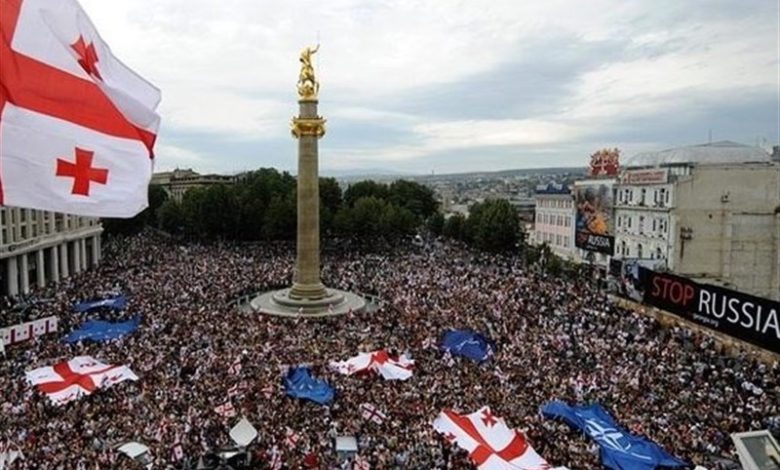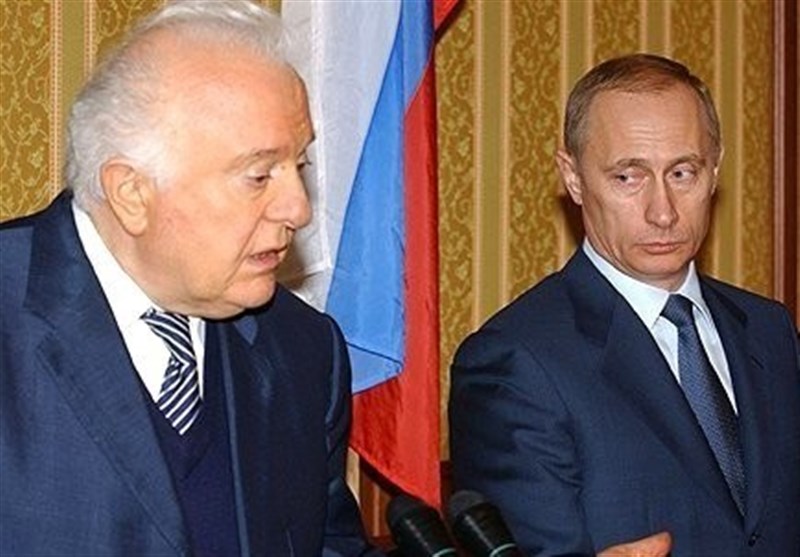Georgia from the inside The foundation of the first color revolution – Part II

| Jane Sharp describes pre-revolutionary situations like this: “All negotiations are based on the size of the stick each side has hidden under the table. It turned out that the main voice of Saakashvili was the opposition media, whose control allowed the protesters to move from words to actions. |
According to the report of the international group Tasnim news agency, further analysis and review The political, social and economic conditions of Georgia, which became the foundation of the world’s first color revolution based on the teachings of Jane Sharp in this country, should be pointed out to the prominent role of non-governmental institutions and organizations affiliated with Western governments and security organizations, as well as the mechanisms used by them. Gird.
Falling popularity of Caucasian fox
After 2002, foreign credit assistance to Georgia was reduced to a minimum, and the Westerners, in justifying this action, considered the lack of visible results of economic reforms and the fight against structural corruption in the country’s administrative system as the most important factor. They announced the reduction and termination of these aids.
The “International Monetary Fund” blocked the 30 million dollar budget for the government’s poverty reduction program, the “European Union” blocked the 24 million euro financial support of the food program. The country refused, and the European Bank for Reconstruction and Development suspended the allocation of 40 million euros for the reconstruction of the Ingori hydroelectric station. was increasing and this had the most negative impact on the popularity of Shevardnadze and his party.
The prospect of economic collapse forced the Georgian authorities to look for new ways to stabilize social, political and economic situation in this country.
Shevardnadze found a relatively clear and safe way to get out of Georgia’s troubled situation. His government decided to expand cooperation with Russia again. This decision was first pursued through buying cheap Russian gas and reviving the economy, and at the same time, with the help of Russian companies, the relatively worn out and partially destroyed energy networks of this country were to be rebuilt.
In May 2003, the Georgian leader met with Alexey Miller, then head of Gazprom, after which Tbilisi announced the preparation of a long-term agreement on energy supplies. But the United States immediately intervened in this matter. Through diplomatic channels, Washington directly asked Tbilisi to stop negotiations with the Russian company.
The fact is that such a deal actually meant the destruction of the American company AES, which at that time claimed It holds the monopoly of energy in Georgia. The company was engaged in energy production using other types of fuel and could not successfully compete with other producing companies focused on cheap Russian gas. Continued negotiations with Gazprom. Soon, the assets of the American company AES Corporation were sold to the Russian company Inter RAO, and the government began preparations for large-scale gas purchases from the Russian Federation.
This decision literally It stunned the United States. It was probably at this moment that the White House decided to make political changes in Georgia and replace Shevardnadze with someone else.
Elections The upcoming parliament was the best time to intervene
The leaders of the Georgian Color Revolution, Berjanidze, Zhovnia, Saakashvili
There were only two months left until the vote on November 2, 2003. During this time, a powerful coalition was formed against Shevardnadze’s ruling party called “For a New Georgia” consisting of the opposition “United National Movement” of Mikheil Saakashvili and “Brjanadze’s Democrats”, led by the former Speakers of the Parliament, Nino Barjanadze and Zorab Zhvania. was led.
Opposition movements quickly gained popularity among the people and society of Georgia, not only against the backdrop of the economic crisis, but also because of Shevardnadze’s reluctance to resolve the issue with Abkhazia and South Ossetia.
The opposition actively played on the nationalist sentiments that were still strong in Georgian society. Saakashvili and his colleagues tried to convince the citizens that the separatism of Abkhazia and South Ossetia was not the result of the nationalist policies of the Gamsakhurdia regime, but the result of the political weakness of the Shevardnadze government.
However, Jane Sharpe’s works inspired the opposition. Shevardnadze, setting up limited and small campaigns in order to highlight a specific problem that is not necessarily the most important problem of the society was of special importance in this plan. The inability of the Georgian government to solve the problem with the unrecognized republics was just one of these problems. Officials do not hope too much, but rely on the support of foreign allies interested in changing the ruling regime. So in the case of Georgia, the most active supporters of the opposition movements were the Soros Foundations, which did not hide multi-million dollar investments in the election campaign. ally was assigned. A significant budget from foreign non-governmental organizations was also spent on supporting the opposition media.
The main speaker of the Saakashvili-Berjanadze-Zhvania trio was the “Rostavy 2” TV channel, whose editorial board, after the broadcast ban, He was forced to work abroad. In November 2003, the Central Election Commission of Georgia revoked the channel’s accreditation due to unprecedented pressure on election commission members during the election period.
George Soros, director of the Soros Foundation and Open Society, who invested the most in creating the Rose Revolution, met with Mikael Saakashvili, the president who emerged from the color revolution in Georgia
At the same time, international observers began to enter the country, including from Western non-governmental organizations, for example, from “Global Strategy”, related With the United States Democratic Party, which specializes in conducting pre-election polls and steering public opinion worldwide.
Voting on November 2 was relatively quiet. “Konstantin Marklov”, the head of the joint observer group of the Interparliamentary Assembly of the Commonwealth of Independent States and the Council of the Russian Federation, reported that the Central Election Commission of Georgia is working “more or less normally”.
However, the announcement of the first results from the polling centers caused stormy protests by the opposition. After counting 50 percent of the votes, the Central Election Commission announced that Shevardnadze’s party “For a New Georgia” won the parliamentary elections with 21.3 percent of the votes.
Pro-government Democratic Revival Union It ranked second with 18.8 percent. Without waiting for the official results to be announced, Saakashvili, Berjanadze and Zhovnia asked the Central Election Commission to invalidate the vote count.
The next day, November 3, the Russians published their predictions. which indicated the clear victory of Saakashvili’s United National Movement with 20% of the votes. Shevardnadze’s party, according to these channels, won only 14 percent of the vote.
This was followed one after another by statements from foreign NGOs about irregularities during voting and counting. . Dozens of social movements, among which Kamara was particularly active, called on citizens to come to the streets and demand Shevardnadze’s resignation without waiting for the publication of the final protocols. Voters mobilized and occupied the streets of Tbilisi, thanks in part to expensive prime-time ads on Georgian television.
Jane Sharpe describes the pre-revolutionary situation: All negotiations are based on the size of the stick that each side has hidden under the table. It turned out that the main voice of Saakashvili was the opposition media, whose control allowed the protesters to move from words to action”.
In those days, up to 10,000 people came to the streets of Tbilisi. This was the beginning of the active phase of the revolution.
span style=”color:red”>and the demand for the dismissal of President Eduard Shevardnadze
The demands of the opposition were supported by representatives of the European Parliament, the Council of Europe and the Office of Democratic Institutions and Human Rights of the Organization for Security and Cooperation in Europe And they asked the Georgian authorities to hold the re-voting.
Edward Shevardnadze’s meeting with the leaders of the Rose Revolution in order to calm the society’s conditions and promise re-election
Shevardnadze tried to personally discuss the current situation with the opposition leaders Share to reduce the level of dissatisfaction. On November 8, he called the opposition leaders to a meeting, but they only repeated the previous ultimatum. At this time, protests continued continuously for a week.
Jane Sharp criticized the idea of negotiation as a method of struggle in his works. He believed that when it comes to the future of “dictatorship”, negotiations cannot be an acceptable way to resolve the conflict. His followers in Georgia, namely Saakashvili, Zhovnia and Berjanadze, firmly adhered to this rule.
Continues…
Researcher Mehdi Saif Tabrizi
end of message/
| Publisher | Tasnim News |



